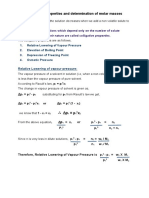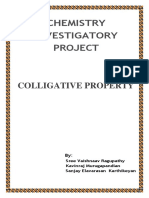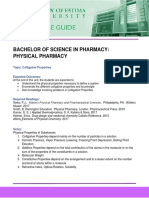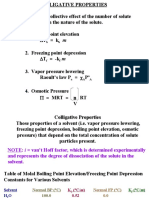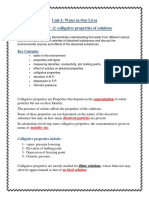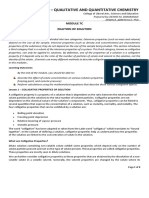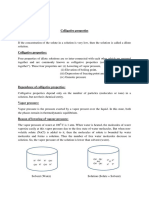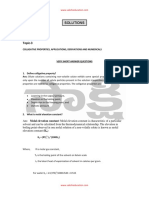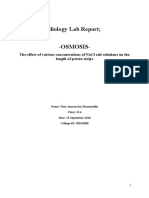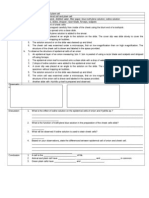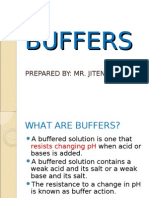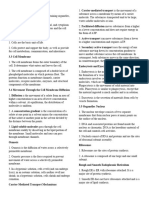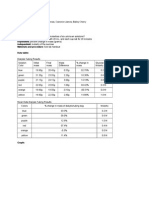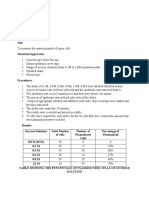CLASS XII APPENDIX-III
TOPIC COVERED- COLLIGATIVE PROPERTIES
Colligative Properties
Those depends upon the number of solute particles (molecule, atoms or ions) but not upon their nature are called
colligative properties. The following are the colligative properties:
(a) Relative lowering of vapour pressure of the solvent.
(b) Elevation in boiling point of the solvent.
(c) Depression of freezing point of the solvent.
(d) Osmotic pressure of the solution.
(a) Relative lowering of vapour pressure: The addition of non-volatile solute to the volatile solvent decreases the
escaping tendency of the solvent molecules from the surface of solutions as some of the surface area is occupied by non-
volatile solute particles. According to Raoult’s law, the relative lowering of vapour pressure is equal to mole fraction of
solute.
𝑃𝐴0 −𝑃 𝑛𝐵
Thus, 𝑃𝐴0
= 𝑥𝐵 = 𝑛𝐴 + 𝑛𝐵
For a dilute solution, nB <<<< nA, hence neglecting nB in the denominator, we have
𝑃𝐴0 −𝑃 𝑛𝐵 𝑊𝐵 × 𝑀𝐴
= =
𝑃𝐴0 𝑛𝐴 𝑀𝐵 × 𝑊𝐴
𝑃𝐴0 𝑊𝐵 ×𝑀𝐴
𝑀𝐵 = ( 0 )×
𝑃𝐴 −𝑃 𝑊𝐴
(b) Elevation of boiling point: Boiling point is the temperature at which the
vapour pressure of a liquid becomes equal to the atmospheric pressure. When
a non – volatile solute is added to a volatile solvent, the vapour pressure of
solvent decreases. In the order to make this solution boil its vapour pressure
must be increased by raising the temperature above the boiling point of the
pure solvent. The difference in the boiling point of solution (T b) and that of
pure solvent is (𝑇𝑏0 ) is called elevation of boiling point (∆𝑇𝑏 ). Thus,
Elevation of boiling point = ∆𝑇𝑏 = Tb - 𝑇𝑏0
For dilute solution, it has been found that the elevation of boiling point is
directly proportional to the molal concentration of the solute in the solution.
Thus,
∆𝑇𝑏 ∝ m or ∆𝑇𝑏 = Kb m
Where Kb is a constant called molal elevation constant or ebullioscopic constant.
When m = 1 mol kg-1 , ∆𝑇𝑏 = Kb
Hence, molal elevation constant may be defined as the elevation in boiling point when one mole of a non- volatile solute
is dissolved in one kilogram (1000 g) of solvent. The unit of Kb is K kg mol-1.
𝑊𝐵 ×1000
As 𝑚= 𝑀𝐵 × 𝑊𝐴
𝐾 × 𝑊 ×1000
Therefore; ∆𝑇𝑏 = 𝑏 𝑀 ×𝐵 𝑊
𝐵 𝐴
𝐾𝑏 × 𝑊𝐵 ×1000
MB = ∆𝑇 × 𝑊
𝑏 𝐴
(c) Depression in freezing point: Freezing point is defined as the temperature
at which the vapour pressure of a substance in its liquid phase is equal to its
vapour pressure in the solid phase. A solution freezes when its vapour pressure
equals to the vapour pressure of the pure solid solvent. Whenever a non – volatile
solute is added to the volatile solvent its vapour pressure decreases and it would
become equal to that of solid solvent at a lower temperature. The difference in
the freezing point of pure solvent (∆𝑇𝑓0 ) and that of the solution (Tf) is known as
depression of freezing point (∆𝑇𝑓 ), thus,
9695977667
�Depression of freezing point = ∆𝑇𝑓 = 𝑇𝑓0 - 𝑇𝑓 .
It has been found that for a dilute solution, depression in freezing is directly proportional to molality of the solution.
∆𝑇𝑓 ∝ m or ∆𝑇𝑓 = Kf m
Where Kf is a constant called molal depression constant or cryoscopic constant.
When m = 1 mol kg-1, ∆𝑇𝑓 = Kf
Hence, molal depression constant may be defined as the depression in freezing point when one mole of non – volatile
solute is dissolved in one kilogram (1000 g) of solvent. The unit of Kf is K kg mol-1.
𝑊𝐵 ×1000
Since, 𝑚= 𝑀𝐵 × 𝑊𝐴
𝐾𝑓 × 𝑊𝐵 ×1000
Therefore; ∆𝑇𝑓 = 𝑀𝐵 × 𝑊𝐴
𝐾𝑓 × 𝑊𝐵 ×1000
MB = ∆𝑇𝑓 × 𝑊𝐴
The values of Kb and Kf which depend upon the nature of the solvent and concentration of the solution, can be ascertained
from the following relations:
𝑅 × 𝑀𝐴 ×(𝑇𝑏0 )2
Kb = ∆𝑣𝑎𝑝 𝐻 ×1000
𝑅 × 𝑀𝐴 ×(𝑇𝑓0 )2
Kf =
∆𝑓𝑢𝑠 𝐻 ×1000
Where, R = Universal gas constant
MA = Molecular mass of solvent
𝑇𝑏0 = Boiling point of pure solvent
∆𝑣𝑎𝑝 𝐻 = Enthalpy of vapourisation of solvent
𝑇𝑓0 = Freezing point of pure solvent
∆𝑓𝑢𝑠 𝐻 = Enthalpy of fusion of solid solvent
(d) Osmosis: When a solution is separated from its solvent by a semipermeable membrane (SPM) there is a spontaneous
flow of solvent molecules from solvent compartment to solution compartment. The phenomenon is called osmosis. This
movement of solvent is only in one direction. In diffusion, however, movement takes place in both the directions.
Semipermeable membrane (SPM): A membrane through which only solvent molecules can pass but not the
solute ones. Cellophane, parchment paper and the wall of living cell are the examples of SPM. It is also made
of inorganic material, copper ferrocyanide [Cu[Fe(CN)6]].
Osmotic pressure (𝝅): The osmotic pressure of a solution is the excess
pressure that must be applied to a solution to prevent osmosis, i.e., to stop the
passage of solvent molecules into it through semipermeable membrane.
Osmotic pressure (𝜋) is proportional to molarity (c) of the solution at a given
temperature T. Thus,
𝜋 = c RT
𝑛𝐵 𝑊 ×𝑅 ×𝑇
Or 𝜋= 𝑅𝑇 = 𝐵
𝑉 𝑀𝐵 ×𝑉
𝑊𝐵 ×𝑅 ×𝑇
Or MB = 𝜋 ×𝑉
Reverse osmosis: If a pressure larger than the osmotic pressure is applied to the solution side, the pure solvent
(or water) flows out of the solution through the semipermeable membrane. In this way the direction of osmosis
is reversed and so the process is called reverse osmosis.
Thus, we can say that reverse osmosis is just opposite to the osmosis when an extra pressure is applied. Reverse
osmosis is used in desalination to get pure water from the sea water.
9695977667
� Isotonic solution: Two solutions are said to be isotonic when they exert the same osmotic pressure because
they have the same molar concentration. All intravenous injections most be isotonic with body fluids.
Isosmostic solution: When two isotonic solutions are separated by a semipermeable membrane, no osmosis
occurs. The solutions are called isosmotic solutions.
Hypotonic solutions: A solution having lower osmotic pressure than the other solution is said to be hypotonic
with respect to the other solution.
Hypertonic solution: A solution having higher osmotic pressure than the other solution is said to be hypertonic
with respect to other solution.
Plasmolyis: When the cell is placed in a hypertonic solution, the fluid comes out of the cell due to osmosis and
as a result cell material shrinks gradually. This process is called plasmolysis.
PROBLEMS RELATED TO THE NOTES:
1. A solution prepared by dissolving 8.95 mg of a gene fragment in 35.0 ml of water has an osmotic pressure of 0.335
torr at 250C. Assuming that the gene fragment is a non-electrolyte, calculate its molar mass. [14193.3 g/mol]
2. When 1.5 g a non – volatile solute was dissolved in 90 g of benzene, the boiling point of benzene raised from 353.23
K. Calculate the molar mass of the solute. (Kb for benzene = 2.52 K kg/mol) [60 g/mol]
3. Calculate the freezing point of a solution containing 60 g of glucose (Molar mass = 180 g/mol) in 250 g of water. (Kf
of water = 1.86 K kg/mol). [270.67 K]
4. At 250C the saturated vapour pressure of water is 3.165 kPa (23.75 mm Hg). Find the saturated vapour pressure of a
5% aqueous solution of urea at the same temperature. (Molar mass of urea = 60.05 g/mol) [3.118 kPa]
0
5. A solution of glucose (Molar mass = 180 g/mol) in water has a boiling point of 100.20 C. Calculate the freezing point
of the same solution. Molal constant for water Kf and Kb are 1.86 K kg/mol and 0.512 K kg/mol respectively.
[272.425 K]
6. At 300 K, 30 g of glucose, C6H12O6 present per litre in its solution has an osmotic pressure of 4.98 bar. If the osmotic
pressure of another glucose solution is 1.52 bar at the temperature, calculate the concentration of other solution.
[0.051 M]
7. Explain why on addition 1 mol glucose to 1 litre water the boiling point of water increases.
8. Why a person suffering from high blood pressure is advised to take minimum quantity of common salt?
9. At higher altitudes, people suffer from a disease called anoxia. In this disease, they become weak and cannot think
clearly. Why?
10. CCl4 and water are immiscible whereas ethanol and water are miscible in all proportions. Correlate this behavior
with molecular structure of these compounds.
9695977667
